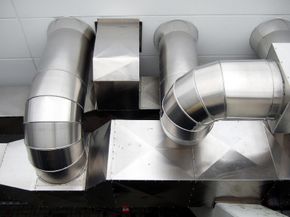Blocking Sound from Windows and Ductwork
Windows are another major source of neighbor noise, especially in a townhome. The average double pane window has an STC of only around 26 [source: Cmar]. There are several ways to improve this rating. First, in situations where windows are a significant source of noise, the resident can replace standard windows with STC-rated varieties, available up to STC 56.
While STC windows are very effective, they can also be expensive and impractical for many people. If this is the case, consider using sound seals instead. Window seal kits are available at most home improvement stores, and are very affordable. They can be installed quickly without the use of special tools, and they can make a big difference in sound transmission. While you're applying your seals, be sure to caulk any cracks or joints you see. Use a clear or matching shade of caulk to trace around the window frame both inside and outside of the home.
Advertisement
For a low-tech solution to neighbor noise passing through the windows, try hanging heavy curtains that run from the floor to the ceiling. Heavy fabric can do quite a bit to dissipate sound. Add a few large, leafy plants near your windows as well. Remember, every bit of sound control you include adds up to reduce the total noise level.
What if noise from your neighbors is traveling into your home through the ductwork? This scenario can be particularly annoying because the sound tends to be amplified in the tight metal space. To combat this problem, wrap your ducts with acoustical insulation, or replace the sections nearest the air grilles and vents with lined duct sections. Another solution is to replace your regular metal grilles with lined versions, or to ask your landlord about adding sound attenuators to the ducts.
And now you're ready to cozy up in your nice, quiet apartment. Sleep well!
Related HowStuffWorks Articles
Sources
- Cmar, David S. Acousticical Windows. September 2005. May 7, 2009.http://www.phaseto.com/acoustical_windows.htm
- Green Glue. Third Party Transmission Loss Reports. 2005. May 8, 2009.http://www.homasote.com/Products/440-Soundbarrier.aspx
- Guardian Insulation. Sound Transmission Class Information. Date Unknown. May 8, 2009.http://www.guardianbp.com/docs/STCbatt.pdf
- Homasote Company. 440 Soundbarrier Product Data. 2009. May 7, 2009.http://www.homasote.com/Products/440-Soundbarrier.aspx
- Krieger Doors. Krieger Soundproof Doors. 2009. May 7, 2009.http://www.kriegerproducts.com/acoustical/
- Manfredini, Lou. "Neighbors too loud? Indoor Noise Solutions." Today Show. September 20, 2007. May 8, 2009.http://today.msnbc.msn.com/id/20874484
- Quiet Solution. Quiet Rock Product Data. December 14, 2007. May 7, 2009.http://www.quietsolution.com/QRock545THX_dsheet.pdf
- STC Ratings. STC Ratings for Various Wall Assemblies. 2004. May 8, 2009.http://www.stcratings.com/assemblies.html
- Vanderheiden, Gregg. About Decibels. Date Unknown. May 7, 2009http://trace.wisc.edu/docs/2004-About-dB
